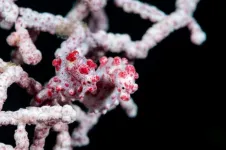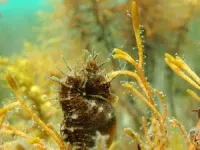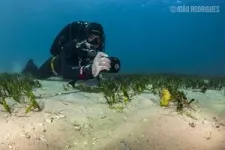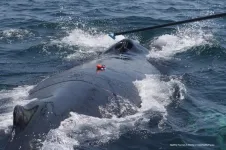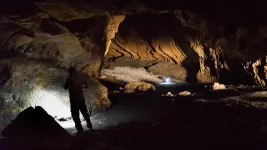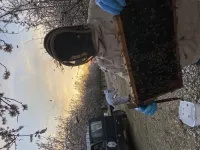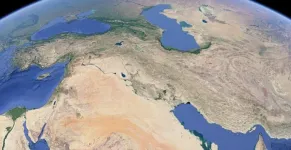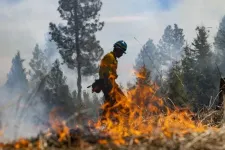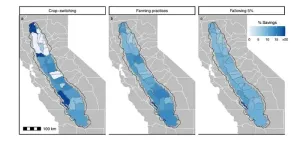(Press-News.org) Thanks to diligent observers, seahorses, those enigmatic and charismatic fish, are not only being discovered in new habitats and expanded geographic ranges, they are also being found at new ocean depths. While their capacity for male pregnancy has long fascinated people, new information on sex ratio and pregnancy seasonality has been discovered by, well, you.
Researchers from Project Seahorse – a marine conservation team based at the University of British Columbia (UBC) and the Zoological Society of London (ZSL) – identified and reviewed new findings related to 35 of the 46 seahorse species found around the globe, all of them posted by citizen scientists using the team’s iSeahorse program, part of the iNaturalist family.
The iSeahorse program allows community, or citizen, scientists – members of the public and non-professional or amateur researchers – to provide information about their sightings of seahorses in the wild. Posting on the website, they provide information about which species of seahorse, when and where in the world they saw it, its habitat, and its depth. They are also asked to provide photographic evidence if they are able.
Undertaking an analysis of 7,794 validated iSeahorse observations from 96 countries and across 35 seahorse species, posted from October 2013 to April 2022, researchers were impressed by the information they gained and its effect on knowledge about seahorses.
“The new findings will enhance global conservation assessments of the species in the world’s definitive IUCN Red List of Threatened Species,” said Elsa Camins Martinez, then a MSc student at UBC’s Institute for the Oceans and Fisheries and first author on the paper.
Camins pointed to contributed observations on Coleman’s pygmy seahorse (Hippocampus colemani), which indicated that its geographic range is thousands of square kilometers larger, its habitat more diverse, and its depth range shallower than previously known. Many of the observations of Hippocampus satomiae were also outside the range reported in the IUCN Red List, suggesting that their range is considerably larger than previously understood.
“Comparing habitat types reported in iSeahorse with those in the IUCN Red List assessment for each species, we found new habitats for 80 per cent of species,” said Dr. Amanda Vincent, UBC professor, co-founder and Director of Project Seahorse, as well as senior author on the research. “We found new habitats for Hippocampus comes, Hippocampus histrix, H. kuda, Hippocampus kelloggi, and Hippocampus spinossisimus, each with five to six new habitats.”
“It was fascinating that the iSeahorse data extended the known breeding season for five species,” added Camins. “In the tropics, seahorses were reported as breeding in every month. Surprisingly, this was also true in the Northern Hemisphere Asian species, although with more breeding in the spring.”
Dr. Vincent is proud of the iSeahorse website. “We reached out to observers in Southeast Asia, Australia, the Caribbean, and Europe – areas with high diving activity – and benefited greatly from being part of the iNaturalist portfolio. As the first biologist to conduct research on seahorses underwater, I am excited how the information provided by participants is helping expand our understanding of the many species. Even for a commonly studied species, the tiger tail seahorses (Hippocampus comes) iSeahorse observations came from outside the IUCN Red List range, with new discoveries in Thailand and Indonesia.”
“With the assistance of our community contributors, we were able to gather information on a much broader scale,” says Heather Koldewey, co-founder of Project Seahorse, ZSL’s Senior Marine Technical Advisor, and co-author on the paper. “This study has demonstrated the value of community science in advancing seahorse knowledge, by helping bridge gaps. Seahorses are very much the sort of fascinating species that benefit from community science, as they are cryptic enough to make even formal research challenging. The results from all these efforts show the importance of promoting marine community science and the important role it can play in conservation, by generating knowledge and mobilizing engagement and action.”
Project Seahorse
Project Seahorse is a leader in marine conservation, making discoveries & and collaborating globally to take effective action for seahorses and their seas. The organization cares for seahorses as flagship animals, conducting cutting-edge research on protected areas, fisheries and wildlife trade… , and applying the new knowledge to produce highly effective conservation interventions. Project Seahorse has won many international awards and honours, and works with researchers, governments, conservation groups and local communities worldwide. Project Seahorse is based at the University of British Columbia, Canada, and Zoological Society of London, UK. Visit www.projectseahorse.org for more information.
ZSL
Founded in 1826, ZSL is an international conservation charity, driven by science, working to restore wildlife in the UK and around the world; by protecting critical species, restoring ecosystems, helping people and wildlife live together and inspiring support for nature. Through our leading conservation zoos, London and Whipsnade, we bring people closer to nature and use our expertise to protect wildlife today, while inspiring a lifelong love of animals in the conservationists of tomorrow. Visit www.zsl.org for more information.
END
Citizen scientists contribute vital information about 35 seahorse species: their geographic ranges, habitats, and pregnancy seasonality
2024-03-25
ELSE PRESS RELEASES FROM THIS DATE:
An effective method for improving energy storage performance in (Bi0.5Na0.5)TiO3-based lead-free relaxor ferroelectrics
2024-03-25
Next-generation advanced high/pulsed power capacitors urgently require dielectric materials with outstanding energy storage performance. (Bi0.5Na0.5)TiO3-based material, a typical lead-free ferroelectrics, has the characteristics of high polarization strength and excellent component compatibility, making it emerge as a potential candidate for energy storage applications.
Researchers have made an interesting breakthrough in the modification of the BNT-based ferroelectrics, an effective method for various properties such ...
Online dashboard to help fight to save children from deadly diarrheal diseases
2024-03-25
University of Virginia researchers are developing a flexible online tool for navigating information used in the fight to save children from deadly diarrheal diseases by identifying transmission hotspots and accelerating the deployment of treatments and new vaccines.
Diarrhea not only kills hundreds of thousands of children around the world every year, it contributes to malnutrition that can prevent kids from growing and developing to their full potential both physically and mentally, trapping them in poverty. While significant progress has been made against the disease in recent years, the UVA researchers say that ...
Caller ID of the sea
2024-03-25
For researchers studying the acoustic behavior of whales, distinguishing which animal is vocalizing is like a teacher trying to figure out which student responded first when the entire class is calling out the answer. This is because many of the techniques used to capture audio record a large sample size of sounds. A major example of this is passive acoustic monitoring (PAM), which records audio via a microphone in one location, usually a stationary or moving platform in the ocean. While this method allows researchers to gather acoustic data over a long time period, it ...
SwRI develops more effective particle conversion surfaces for space instruments
2024-03-25
SAN ANTONIO — March 25, 2024 —Southwest Research Institute is investing internal funding to develop more effective conversion surfaces to allow future spacecraft instruments to collect and analyze low-energy particles. Conversion surfaces are ultra-smooth, ultra-thin surfaces covering a silicon wafer that convert neutral atoms into ions to more effectively detect particles from outer space.
Changing the charge of particles simplifies and enhances detection and analysis capabilities. Dr. Jianliang Lin of the Institute’s Mechanical Engineering Division and Dr. Justyna Sokół of SwRI’s Space Science Division lead the multidisciplinary project. The project builds ...
Novel quantum algorithm for high-quality solutions to combinatorial optimization problems
2024-03-25
Combinatorial optimization problems (COPs) have applications in many different fields such as logistics, supply chain management, machine learning, material design and drug discovery, among others, for finding the optimal solution to complex problems. These problems are usually very computationally intensive using classical computers and thus solving COPs using quantum computers has attracted significant attention from both academia and industry.
Quantum computers take advantage of the quantum property of superposition, using specialized qubits, that can exist in an infinite yet contained number of states of 0 or 1 or any combination of the two, to quickly ...
Persian plateau unveiled as crucial hub for early human migration out of Africa
2024-03-25
A new study combining genetic, palaeoecological, and archaeological evidence has unveiled the Persian Plateau as a pivotal geographic location serving as a hub for Homo sapiens during the early stages of their migration out of Africa.
This revelation sheds new light on the complex journey of human populations, challenging previous understandings of our species' expansion into Eurasia.
The study, published in Nature Communications, highlights a crucial period between approximately 70,000 to 45,000 years ago when human populations did not uniformly spread across Eurasia, ...
Honey bees at risk for colony collapse from longer, warmer fall seasons
2024-03-25
PULLMAN, Wash. – The famous work ethic of honey bees might spell disaster for these busy crop pollinators as the climate warms, new research indicates.
Flying shortens the lives of bees, and worker honey bees will fly to find flowers whenever the weather is right, regardless of how much honey is already in the hive. Using climate and bee population models, researchers found that increasingly long autumns with good flying weather for bees raises the likelihood of colony collapse in the spring.
The study, published in Scientific Reports, focused on the Pacific Northwest but holds implications for hives across the U.S. The researchers ...
20,000 years of shared history on the Persian plateau
2024-03-25
All present day non African human populations are the result of subdivisions that took place after their ancestors left Africa at least 60.000 years ago. How long did it take for these separations to take place? Almost 20.000 years, during which they were all part of a single population. Where did they live for all this time? We don’t know, yet.
This is a conversation that could have taken place one year ago, now it is possible to give clearer answers to these questions thanks to the study recently published in Nature Communications (1) led by the researchers from the University ...
New UM study reveals unintended consequences of fire suppression
2024-03-25
MISSOULA – The escalation of extreme wildfires globally has prompted a critical examination of wildfire management strategies. A new study from the University of Montana reveals how fire suppression ensures that wildfires will burn under extreme conditions at high severity, exacerbating the impacts of climate change and fuel accumulation.
The study used computer simulations to show that attempting to suppress all wildfires results in fires burning with more severe ecological impacts, with accelerated increases in burned area beyond those expected from fuel accumulation or climate change.
“Fire suppression has unintended consequences,” said lead author Mark Kreider, a Ph.D. ...
Small changes can yield big savings in agricultural water use
2024-03-25
(Santa Barbara, Calif.) — While Hollywood and Silicon Valley love the limelight, California is an agricultural powerhouse, too. Agricultural products sold in the Golden State totaled $59 billion in 2022. But rising temperatures, declining precipitation and decades of over pumping may require drastic changes to farming. Legislation to address the problem could even see fields taken out of cultivation.
Fortunately, a study out of UC Santa Barbara suggests less extreme measures could help address California’s water issues. Researchers combined remote sensing, big data and machine ...
